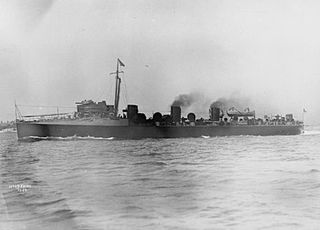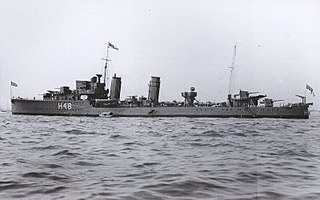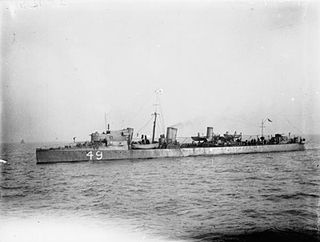
USS Robinson (DD-88) was a Wickes-class destroyer in the United States Navy, later transferred to the Royal Navy, as HMS Newmarket (G47). She was the first ship named for Isaiah Robinson.

HMS Campbeltown was a Town-class destroyer of the Royal Navy during the Second World War. She was originally US destroyer USS Buchanan, and was one of 50 obsolescent U.S. Navy destroyers transferred to the Royal Navy in 1940 as part of the Destroyers for Bases Agreement. Campbeltown became one of the most famous of these ships when she was used in the St Nazaire Raid in 1942.

The Laforey class was a class of 22 torpedo boat destroyers of the Royal Navy, twenty of which were built under the Naval Programme of 1912–13 and a further two under the 2nd War Emergency Programme of 1914. As such they were the penultimate pre-war British destroyer design. All served during World War I during which three were lost; the survivors were all scrapped in 1921-23.

USS Satterlee (DD-190) was a Clemson-class destroyer in the United States Navy, entering service in 1919. After brief service until 1922, the ship was placed in reserve. The ship was reactivated for World War II before being transferred to the Royal Navy in 1940. Renamed HMS Belmont, the destroyer was used as a convoy escort in the Battle of the Atlantic where she was torpedoed and sunk on 31 January 1942.

The River-class destroyer was a class of torpedo boat destroyer built for the Royal Navy in the first few years of the 20th century, and which saw extensive service in World War I. These 37 vessels were all constructed to disparate builders' designs, just like the preceding classes.

The Abdiel class were a class of six fast minelayers commissioned into the Royal Navy and active during the Second World War. They were also known as the Manxman class and as "mine-laying cruisers". These ships were armed with a wide variety of defensive weapons from 0.5-inch (13 mm) machine guns to the 4-inch (100 mm) main armament. They were also equipped with a wide array of radars, along with their normal complement of mines. They were easily mistaken for destroyers. Half the class was lost through enemy action during the Second World War; the others saw post-war service, and the last example was scrapped in the early 1970s.

HMS Decoy was a D-class destroyer of the Royal Navy. Ordered in 1931, the ship was constructed by John I. Thornycroft & Company, and entered naval service in 1933. Decoy was initially assigned to the Mediterranean Fleet before she was transferred to the China Station in early 1935. She was temporarily deployed in the Red Sea during late 1935 during the Abyssinia Crisis, before returning to her duty station where she remained until mid-1939. Decoy was transferred back to the Mediterranean Fleet just before the Second World War began in September 1939. She briefly was assigned to West Africa for convoy escort duties in 1940 before returning to the Mediterranean. The ship participated in the Battles of Calabria without significant damage and escorted ships of the Mediterranean Fleet for most of the rest of the year.

HMS Chamois was a Palmer three-funnel, 30-knot destroyer ordered by the Royal Navy under the 1895–1896 Naval Estimates. She was the first ship of the Royal Navy to carry this name. She was commissioned in 1897 and served in both the Channel and the Mediterranean. She foundered in 1904 after her own propeller pierced her hull.

HMS Fairy was a three-funnel, 30-knot destroyer of the First World War. One of three similar ships built by Fairfields for the Royal Navy, she was ordered under the 1896–1897 Naval Estimates and the sixth Royal Navy ship to carry this name. She was classified, along with other similar ships, as a C-class destroyer in 1913. She sank in 1918 from damage inflicted by ramming and sinking the German submarine UC-75.

HMS Cheerful was a 30-knot, three-funnel torpedo boat destroyer built by Hawthorn Leslie. She was ordered by the Royal Navy under the 1896–1897 Naval Estimates, launched in 1898, and saw action during World War I. She was mined off the Shetland Islands in 1917 and sank with the loss of 44 officers and men.

HMS Veteran was an Admiralty modified W-class destroyer built for the Royal Navy. She was ordered in April 1918 from John Brown & Company under the 14th War Program. She was the third Royal Navy ship to carry the name.

HMS Crescent was a C-class destroyer which was built for the Royal Navy in the early 1930s. The ship was initially assigned to the Home Fleet, although she was temporarily deployed in the Red Sea and Indian Ocean during the Abyssinia Crisis of 1935–36. Crescent was sold to the Royal Canadian Navy in late 1936 and renamed HMCS Fraser. She was stationed on the west coast of Canada until the beginning of World War II when she was transferred to the Atlantic coast for convoy escort duties. The ship was transferred to the United Kingdom (UK) in May 1940 and helped to evacuate refugees from France upon her arrival in early June. Fraser was sunk on 25 June 1940 in a collision with the anti-aircraft cruiser HMS Calcutta while returning from one such mission.

HMS Crusader was a C-class destroyer built for the Royal Navy in the early 1930s. She saw service in the Home and Mediterranean Fleets and spent six months during the Spanish Civil War in late 1936 in Spanish waters, enforcing the arms blockade imposed by Britain and France on both sides of the conflict. Crusader was sold to the Royal Canadian Navy (RCN) in 1938 and renamed HMCS Ottawa. She was initially deployed on the Canadian Pacific Coast before World War II, but was transferred to the Atlantic three months after the war began. She served as a convoy escort during the battle of the Atlantic until sunk by the German submarine U-91 on 14 September 1942. Together with a British destroyer, she sank an Italian submarine in the North Atlantic in November 1941.

HMS Flirt was a Palmer three funnel, 30 knot destroyer ordered by the Royal Navy under the 1896 – 1897 Naval Estimates. She was the fifth ship to carry this name since it was introduced in 1782 for a 14-gun brig in service until 1795.

HMS Wanderer (D74/I74) was an Admiralty modified W class destroyer built for the Royal Navy. She was the seventh RN ship to carry the name Wanderer. She was ordered in January 1918 to be built at the Fairfield Shipbuilding and Engineering Company, Govan in Glasgow, being launched in May 1919. She served through World War II where she was jointly credited with five kills on German U-boats, more than any other ship of her class. In December 1941 the community of Sutton Coldfield in Warwickshire officially adopted her. In 1943 she was one of twenty one V&W class destroyers to be converted as Long Range Escorts. She was decommissioned after the war and sold for scrap in 1946.
HMS Leven was a Fairfield "30-knotter" destroyer of the Royal Navy, later classified as part of the C class. It was built in 1898–1899, and served with the Royal Navy through to the First World War, sinking a German U-boat in 1918. Leven was sold for scrapping in 1920.

HMS Fame was a two funnel, 30 knot destroyer of the Royal Navy, ordered under the 1894–1895 Naval Estimates. She was launched in 1896, served in Chinese waters for the whole of her life and was sold at Hong Kong in 1921.

HMS Coquette was a two funnel, 30-knot destroyer ordered by the Royal Navy under the 1896 – 1897 Naval Estimates. She was the fifth ship to carry this name. She was launched in 1897, served in home waters before World War I, and as a tender to the gunnery school at Sheerness during the war. She was sold for breaking in 1920.

HMS Kestrel was a Clydebank-built three funnelled 30-knot destroyer ordered by the Royal Navy under the 1895 – 1896 Naval Estimates. She was the fourth ship to carry this name since it was first used in 1846 for a brigantine.

HMS Falcon was a Fairfield three-funnel, 30 knot destroyer ordered by the Royal Navy under the 1898 – 1899 Naval Estimates. She spent her life in Home waters, was part of the Dover Patrol during World War I and was lost in a collision on 1 April 1918.



















